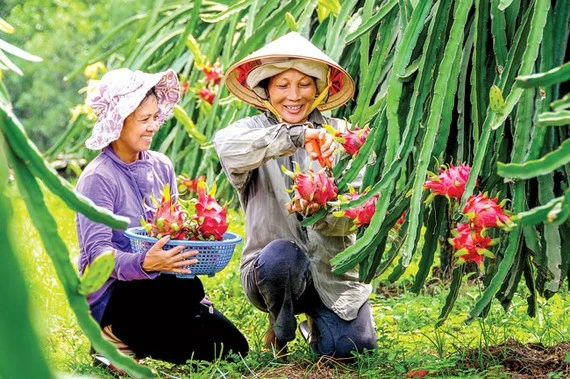
However, in the first nine months of 2019, fruit and vegetable exports decreased by 4.3% compared to the same period in 2018, and it is forecast that the fruit and vegetable industry will not reach their planned target by the end of this year.
China tightens quality standards
In 2017, Vietnam's vegetable industry had reached an unprecedented record high of over USD 3 bn, when export turnover of the whole industry went up by 42.5% compared to 2016. This helped the industry join the top four highest export value agricultural products.
At that time, the Chinese market still accounted for more than 70% of Vietnam's total vegetable exports at USD 2.65 bn (up 52.43% compared to the previous year). That was also the year when Vietnamese vegetables recorded many accomplishments by entering fastidious markets such as Japan, the US, and Australia, which demand very high export value and quality. Vegetables and fruits were then expected to have an impressive and steady year by year growth and reach USD 10 bn by 2025.
With the momentum of growth in 2017, vegetables were expected to reach higher in 2018. However, the turnover of the whole year of 2018 was only around USD 3.5 bn, an increase of just 10.8% compared to 2017. Despite this, exports of vegetables and fruits still far outstripped many commodities such as tea, pepper and rice.
In 2018, China remained Vietnam's largest fruit and vegetable import market, with more than 70% of total turnover. Notably, from the second half of 2018, China began to tighten the quality of imported goods and transferred imports from unofficial channels to official ones.
In 2019, the vegetable industry was quite confident when planning an export turnover of USD 4-4.2 bn, but by the end of September, this figure only reached USD 2.84 bn (down 4.3% compared to the same period). Vietnam Fruit and Vegetable Association has forecast that this year the industry will only reach the same turnover as in 2018, meaning that it is difficult to reach the turnover as planned.
There were some reasons for this decline. In April, pineapple traders in Lao Cai had to dump thousands of tons of pineapples as China stopped importing. Pineapple is not on the list of fruits that are officially exported to China, but it is now more difficult when exporting unofficially. Consequently, vegetable export turnover in May decreased by 23.1% compared to the previous month.
Talking with Saigon Investment, Mr. Dang Phuc Nguyen, General Secretary of Vietnam Fruit and Vegetable Association, said that the reason why Vietnam's vegetable and fruit exports had continuously declined in the past few months was because the Chinese market had become much more tighter. Other markets have grown but due to low turnover, they could not compensate for the decline from this main market.
Specifically, from June 1, Vietnamese vegetables and fruits must be exported through official channels only. Currently with fruits, China imports nine types from Vietnam, namely, dragon fruit, banana, watermelon, litchi, longan, mango, jackfruit, rambutan and mangosteen. In particular, China strictly enforces regulations on traceability which requires products to have a planting area code and a packing facility code. As soon as the Chinese market tightened, fruit and vegetable exports to China in July dropped to a low 44%.
Breakthrough in post-harvest processing
Although Vietnam's vegetable industry in recent years has experienced a strong growth period, most of the exports are raw fruits and vegetables and the post-harvest processing industry has not yet been expanded.
“Lack of capital, technology and raw material are the reasons why post-harvest processing cannot flourish. In addition, because the investment in this industry must be long-term while the payback period is too long, many businesses are not interested in it”, added Dang Phuc Nguyen.
In fact, there are 71 processing facilities in the South of Vietnam, but most of them are short of raw materials and only reach 50% of designed capacity. Currently, the country has an output of 27 million tons of vegetables and fruits per year, but the factories can only use 1 million ton/year due to low quality materials.
Mr. Ung The Lam, who has a lot of experience in exporting fruits to difficult markets, acknowledges the increasing demand for processed fruits and vegetables in the world, but consumers require the product to have high quality and good trademark brand. Therefore, raw materials used in production must be strictly checked.
Several studies have shown that the processed vegetable market is increasing remarkably. Global fruit juice market alone is worth USD 160 bn and will maintain a growth rate of 5-6% in the next few years. The most advanced processing technologies in the world make consumers feel that delicious fruit juice is no different from natural juice, thereby fulfilling the ever-changing demands of consumers.
Vietnam certainly cannot miss the opportunity to join this lucrative industry and the transition to growing safe vegetables and fruits according to international standards, such as Global Gap, which may initially slow the export of raw vegetables, but will be a good stepping stone for both raw and deep processing in the future.




















